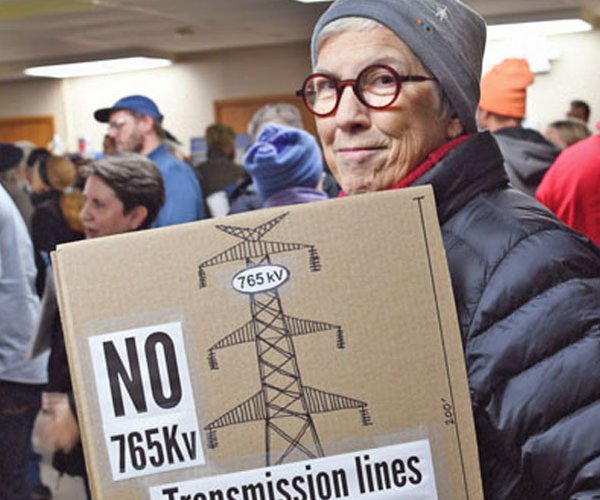SPARTA - During recent extreme flooding events in Southwest Wisconsin, local residents would maze around a hodge-podge of forecasting information, trying to gain an understanding of what is happening in real time. Local news, National Weather Service Hydrologic Forecasts, and even Facebook became lifelines to residents concerned about what was headed their way.
Flood control dams breached after a catastrophic rain event in the headwaters of the Kickapoo River, Coon Creek and Little LaCrosse River watersheds. Communities like Bloomingdale and Avalanche in the West Fork, Ontario in the Kickapoo River Main Stem, Chaseburg and Coon Valley in Coon Creek, and Melvina and Leon in the Little LaCrosse watersheds had little to no advance warning when tsunami-like flash floods swept into their communities in the middle of the night in August of 2018.
Individuals camping or canoeing on the Kickapoo Valley Reserve may not receive enough warning to evacuate campsites or get off the river. Timely information from upstream is critical to public safety there.
Others downriver, anticipating river flooding, may simply be trying to determine how to protect their property or find a route to work.
Current resources to help forecasters and local first responders understand what is happening in these kinds of situations often aren’t well enough developed outside of urban centers, or for the smaller tributaries of larger watersheds.
USGS maintains river gauges in Ontario, LaFarge and Steuben which provide information on stream flow, and the National Weather Service has a similar gauge in Readstown. These gauges provide information about the volume of water that is passing along the water body at that location, but do not provide information about the levels of water.
These challenges, and concern for public health and safety, have led the Monroe County Board of Supervisors to adopt a climate change resolution. That resolution created a ‘Climate Change Task Force,’ and that task force has adopted 10 goals. The first of those ten goals is “Implement monitoring devices (weather stations) and warning systems in real time by coordinating with emergency management and the National Weather Service.”
Representatives from U.S. Senator Tammy Baldwin, U.S. Representative Ron Kind, and State Senator Jennifer Shilling’s office, attended the meeting of the task force on Wednesday, Dec. 11 in Sparta. State Representative Loren Oldenburg attended the meeting in person, as did representatives from the U.S. Geological Survey, USDA-NRCS, National Weather Service - LaCrosse, and the Wisconsin DNR. The invited speaker at the meeting was Nathan Young, Associate Director of the Iowa Flood Center.
In addition to Monroe County, Climate Change Task Forces have been enacted by county boards in Eau Claire, Dane and Milwaukee counties.
Discussions are currently in progress among county conservation officials in the Kickapoo and Coon Creek watersheds about how they can collaborate around issues of flooding and public safety. Pam Porter, DNR Policy Advisor in the Governor’s office and member of the state’s newly formed Climate Change Task Force attended the meeting in Sparta.
Iowa Flood Center
Iowa has had many flooding emergencies in the last decade, and their efforts to provide more useful flood prediction information were jump started after catastrophic flooding in 2008. More than 201 miles of primary highway washed out from the flooding, and estimated damages totaled over $10 billion. Of Iowa’s counties, 86 of 99 received federal disaster declarations.
In the aftermath of the flood, legislators approached Iowa Hydroscience and Engineering Director Larry Weber about “how to prevent this kind of flooding from ever happening again.”
Weber and another professor of civil and environmental engineering, Witold Krajewski, talked with legislators and agreed to write a proposal about what their department could do to help improve that state’s response to flooding. Their proposal to create a state-funded flood center served as the basis for a law passed in 2009 creating the Iowa Flood Center (IFC).
The legislature provides the center with base funding of $1.5 million per year. This amounts to about 50 cents per Iowan per year. These funds are used to pay core staff salaries, and to leverage additional grant funding for projects. Over the last decade of their existence, the center has taken their $13.8 million in state funding and used it to secure $127 million for flood-first projects directly benefiting Iowans.
“Iowa is light years ahead of Wisconsin in flood preparedness,” Monroe County Conservationist Bob Micheel said. “Their work provides an example of where our task force is looking to go.”
Flood information system
Young discussed his agency’s development of the Iowa Flood Information System (IFIS). This tool gives the public easy online access to information about rainfall, river and stream levels, flood predictions, and flood inundation maps for 26 communities in Iowa.
These resources show what a predicted flood stage will mean for homes, businesses and schools. It puts data directly in the hands of people who need it – emergency managers, public safety personnel, and the public. This information allows Iowans to make better decisions to protect their property, families and livelihoods.
To view their website and the flood prediction tools available to Iowa citizens, go to ifis.iowafloodcenter.org .
In 2010, the agency released their first community-based flood inundation maps for Iowa City, Des Moines, Cedar Falls and Waterloo. IFC and Iowa DNR partnered with and received $15 million from the U.S. Department of Housing and Urban Development (HUD) to update floodplain maps throughout the state. Those maps show the probability, extent and depth of flooding for every Iowa stream draining more than one square mile. Each year a few more communities are added into the online tool.
The method used to update the floodplain maps, which were eventually accepted by FEMA, was to use LiDAR data provided by the Iowa DNR to map the streams. This allowed researchers to precisely map Iowa’s river and stream network, develop computer-based flood simulations, and delineate floodplains with reasonable accuracy.
The floodplain maps define the boundaries for 100-year (one percent annual chance of flood) and 500-year (0.2 percent chance) floods. Funding from the Iowa Natural Heritage Foundations allowed the team to also create maps for 2, 5, 10, 25, 50 and 200-year floods.
Upon FEMA review and approval, the maps have become regulatory. Updating the maps has helped communities to more accurately assess which residents require flood insurance and what their premiums should be.

Stream sensors
The Iowa DNR also contracted with the IFC in 2010 to build and deploy a network of 50 stream sensors. Students built the initial prototype of the instrument, which measures stream height via ultrasonic sonar. The instruments’ measurements are uploaded every 15 minutes into the IFCs online tool. Funding for an additional 50 sensors was provided in 2012. In 2014, another 50 stream sensors were deployed, bringing the total number to 200. By spring of 2019, that number had increased to 250.
These stations are placed in locations on bridges where USGS does not locate their gauges, providing more localized forecasts. Each station costs about $3,500. The stations are much less expensive than those deployed by USGS, allowing for a broader distribution.
Hydrologic network
In 2013, IFC and NASA partnered on a project that would provide additional crucial pieces of information into their online tool – rain gauges to measure local rainfall amounts. These gauges were deployed along with soil moisture and temperature probes. The stations also feature a shallow monitoring well to measure the water table. The first pilot project took place in the Turkey River watershed.
Student researchers work with NASA to compare the sensors on the ground to the results of NASA’s Soil Moisture Active Passive (SMAP) satellite. In 2018, IFC deployed another 20 stations and received requests from over 100 partners across the state. These stations cost about $15,000 apiece to deploy, and IFCs goal is to place one in each of Iowa’s counties.
This has provided invaluable information to weather forecasters and added a dimension to the information available on the IFC’s website. But the information is also very valuable to farmers, and some of the hydrologic stations are located on farms. The information allows farmers to learn when the soil is ready to plant, the best time for field applications, and how to plan for changing weather conditions.
Watershed approach
Iowa also received $8.8 million from HUD for the Iowa Watersheds Project (IWP). That program is overseen by the IFC, and established the first watershed management authorities (WMAs) in Iowa. Authority for WMAs is granted by statute. Projects are limited to HUC-8 watersheds or smaller. The WMA is a self-governed non-profit, and individuals from municipalities, counties, and soil and water conservation districts can sit on their boards.
Their purpose is to establish small-scale flood mitigation projects in sub-watersheds. Creating the authority allows counties and municipalities in a watershed to work together to obtain funding, and to implement watershed-based projects.
In 2016, Iowa received a $97 million grant from a HUD-Rockefeller Foundation National Disaster Resilience Competition to implement a project called the ‘Iowa Watershed Approach’ (IWA). Projects were completed for the first five watersheds in 2016.
By spring 2019, IFC researchers had completed hydrologic assessments in each of Iowa’s watersheds. These assessments include the watershed’s hydrology, geology and soils, topography, and land use. These assessments are used to create models of flood reduction and water quality improvement impacts from installation of conservation practices.
With the information from these assessments, project coordinators engage with volunteer landowners (who are eligible for 90 percent cost-share) from USDA-NRCS to strategically site conservation practices such as ponds, terraces and wetlands. These projects, launched in 2019, are designed to reduce downstream flood impacts. So far, project coordinators are working with 125 landowners to identify sites for nearly 480 practices across eight watersheds.




